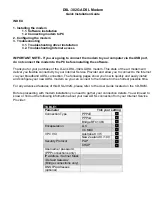
0049-1800-xxx 326X V.34, V.34-SDC and V.32bis Series Modem – USER’S GUIDE 02/23/2010
Rev. A
Page 151
of
205
Table B-6.
Vendor Wire for 326X
NOTE
: To determine cable length, add the conductor and shield capacitance specified above to determine the total wire
capacitance. For example, if you are using a Belden wire (Part Number 9671), add the conductor capacitance of 30 pF/ft
and the shield capacitance of 55 pF/ft for a total capacitance of 85 pF/ft. If you are operating at a rate of 19.2 kbps, the
maximum allowable cable length to attain throughput of 19.2 kbps is 28.24 feet. Multiplying 28.24 by the total cable
capacitance of 85 pF/ft yields a maximum allowable cable capacitance of 2410.4 pF, which is acceptable in accordance
with Table B-4.
DTE Cable Diagnostics
This section helps determine whether there is a problem with a DTE cable. Perform the following
steps before continuing with installation. If you continue to experience problems with data
transmission after choosing a cable running the diagnostics in this section, the problem may be with
your DTE or modem.
If the modem
is not installed
at a host site
, perform the following steps:
1)
Enable the AT ACU (if not already enabled) with async echo on (reinitializing the modem will
also enable the AT ACU with async echo set to on). Ensure that rate and parity of the modem
and the DTE are identical.
2)
Send data to the modem from the DTE.
NOTE
: Do not substitute test equipment for the DTE, as
the DTE’s receivers/drivers are used in this test.
3)
If echoed data from the modem (as received by the DTE) matches the transmitted message, send
the status screen (AT
*
ST<CR>) command.
4)
If there are no errors in either of the previous tests, the cable is appropriate for your application.
5)
If the transmitted and received messages are different (i.e., character or framing errors), verify
the cable length to the limit specified in Table B-4. Reduce the cable length or capacitance of the
















































